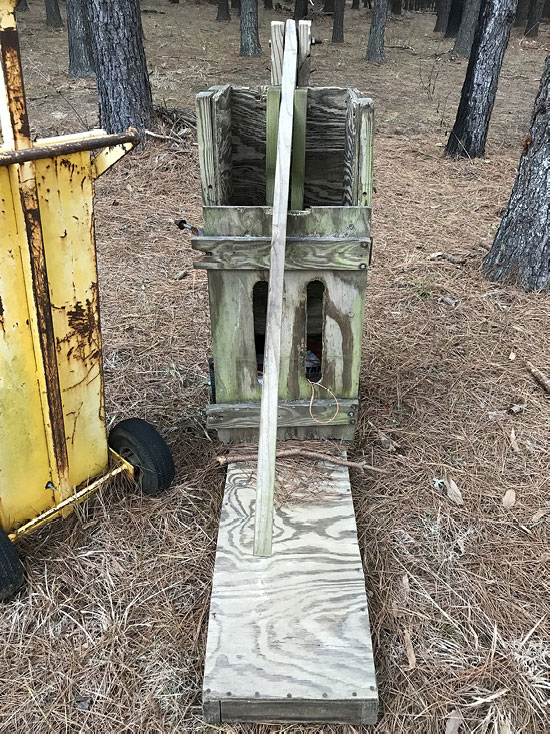Pine Straw: Harvesting the Product
Forest landowners have many opportunities to diversify the products they manage. In addition to timber and wildlife, landowners can lease their land for recreation, grow pole timber and veneer, or propagate a variety of products intended for human consumption. Although North Carolina, Florida, and Georgia continue to dominate the pine straw industry, there is interest in harvesting pine straw in Mississippi while simultaneously managing for timber.
Pine straw is a popular landscape mulching material because of its insulating and aesthetic qualities. In addition, it has many advantages over other mulches. For example, it does not float and wash away like bark chips; it can be easier to apply and costs less than stone; and, unlike synthetics, it adds nutrients and promotes soil tilth in landscaping beds to stimulate healthy plant development.
This publication addresses harvesting, including expected yields, timing, location, equipment and labor, preparing for harvest, raking and baling, and potential impacts of litter removal. As with all forest activities, a management plan outlining objectives, stand characteristics, and other information should be completed before harvesting pine straw.
Yields
A pine tree typically retains its needles for 2 years, after which they shed and new ones grow. For unfertilized stands, needle fall tends to increase annually up to age 15, when needle production reaches a maximum, and then declines slightly each year. Needle fall then remains steady until around age 35. In addition to stand age, straw production rates are closely correlated with basal area of the stand and site characteristics.
Loblolly tends to have higher production than slash and longleaf pine. Although pine straw production research is limited for Mississippi, loblolly pine straw production should reach its upper level (3,500–5,500 pounds per acre per year) when stand basal area approaches 100–125 square feet per acre (Dickens et al. 2011; Taylor and Foster 2004). This corresponds to 175 to 275 20-pound bales per acre.
Slash pine plantations produce slightly less pine straw, from about 3,000 pounds per acre up to about 5,000 pounds per acre per year, or 150–250 20-pound bales per acre (Gholz et al. 1985). Although vendors tend to prefer longleaf pine straw because of its color retention, longer needle length, and slower rate of deterioration, the species has the lowest rate of production. Annual longleaf pine straw production rates range from 100 to 250 20-pound bales per year, or 2,000–5,000 pounds per acre (Dickens et al. 2018; Duryea 2000).
For less intensively managed mature plantations and mixed stands, rates are lower for a given basal area. The important thing for landowners to remember is that production increases with stand density up to about 15 years of age. However, tree health and productivity must also be considered, along with possible financial tradeoffs.
For example, a basal area of 75 square feet provides enough shade to minimize herbaceous vegetation on the forest floor, allowing for efficient removal of straw. However, there may be a financial tradeoff because this may be more basal area than is typically left after thinning operations and may affect final harvest volumes.
The landowner can estimate density using an angle gauge, prism, or ask a professional forester to determine basal area. In addition to biological factors, other critical limits for removal include raking efficiency and time between harvests.
When to Harvest
Stand age is very important regarding harvesting pine needles. The stand of trees should be at least 8 years old. A forester can help determine the age of the trees. Harvesting pine straw too early is typically not profitable due to lower levels of needle production at earlier ages. Further, pine straw harvesting can potentially remove too much organic matter and valuable nutrients from cycling back into the soil of the growing stand, which can impact growth rate of products more valuable than pine straw. Harvesting too late has a similar effect—lost income through missed opportunity costs.
Similar to other species of trees, pines start shedding needles in the fall when growth rate slows by about 50 percent. Unlike broad-leafed trees, though, pines do not enter true dormancy in the winter. Greatest needle fall is from September through December, so it is possible to rake needles from winter to early spring when the highest volume of pine straw is sold. During this time, the temperature is cooler and there is less understory vegetation.
However, wet weather makes baling difficult because water increases weight of the straw. Rake and bale needles when they are dry, or store moist straw in a drying barn until it dries. Harvesting during wet weather can also result in soil compaction and erosion. For these reasons, the ideal time for harvesting is early to mid-fall. The goal is to start getting the stand ready early so everything is ready to harvest when pine straw production peaks.
Harvesting Location
Production sites should be identified on maps in the forest management plan. They should have slopes no greater than 8 percent. Excessively well-drained soils should be raked no more than once every 3 years to conserve soil moisture, organic matter, and nutrients needed for timber production.
In a pine plantation, ideal spacing between rows depends on the size of harvesting equipment. Newer equipment requires at least 8 feet between rows. Remember, as trees age, ground-level trunk diameter will increase. Consideration for this growth is warranted, and appropriate row spacing may be 10 feet or greater.
Hand baling can be used on a wider variety of sites and spacings, including more open naturally regenerated stands. Logging decks and roads can provide sites where straw is loaded onto a closed trailer. Mississippi best management Practices should always be implemented to protect site quality.
Equipment and Labor
Before determining when to harvest, you must decide if you want to harvest the straw yourself or contract with a harvester. Considerations include the capacity to collect straw on available acreage and access to equipment. While it is possible for a single person to bale straw, most crews have two to five people. One person usually uses a rake or pitchfork to rake straw away from the trees, and another person operates a tractor or hand baler to collect the straw. A third person collects baled straw on a trailer to deliver to market.
Pine straw baling can be contracted through a per-bale lease or by the acre. Harvesters tend to prefer lower risk per-bale leases, while landowners tend to prefer per-acre leases due to the set cost. Per-bale leases may offer up to 25 cents per bale, and per-acre leases can result in up to $50 per acre depending on site preparation and stand maintenance costs. Landowners should obtain competitive bids every 3 to 5 years to ensure up-to-date values.
The key to baling is managing to hold straw together using baling twine. Longer needles, such as those of longleaf pine, make baling easier. A wooden hand baler can be sufficient for small properties, hilly terrain, natural stands, and wet weather. These balers can be built for less than $100. The limitations of a hand baler include intensive labor, slow production, and difficulty in getting twine tight enough to hold straw together. A binding machine should be used along with a hand baler to ensure tight wrapping. Hand balers typically yield 20-pound bales. Plans for wooden hand balers are available online (Figure 1).

A mechanical baler is more efficient for use in plantations and can yield bales up to 40 pounds. Machine-produced round bales tend to be marketed by commercial operations and are used in large landscaping projects. A mechanical baler is attached to a tractor and will require wider row spacing.
Other than mechanical maintenance, the most critical limitation with mechanical balers is the amount of effort required in site preparation before baling. Sites must be carefully cleaned of limbs, cones, debris, and vegetation because these make baling difficult. Mechanical balers can cost several hundred dollars and will not tolerate wet straw as well as hand balers (Figure 2).

Preparing for Harvest
Costs for harvesting pine straw vary by location and size of operation, but a ballpark estimate may approach $200 per acre as an initial cost for up to a 50-acre operation. This translates to about $5 per 40-pound bale. This initial cost is primarily linked with preparing the site for mechanical harvesting. Costs diminish following the initial investment and are better distributed in operations with higher acreages. Harvesting and marketing costs hover around $2 per bale for a cleaned stand throughout the remaining harvesting years.
Large commercial operations may need more equipment to keep up with production. Some commercial productions can invest tens of thousands of dollars in harvesting equipment, storage, trucks, and trailers.
About 3 to 4 weeks are typically needed to prepare, bale, and market straw from a 40-acre plantation. Pruning is necessary in machine baling operations. Trees should be pruned starting at a young age to ensure limbs are high enough that they will not impede operations.
Green limbs should not be pruned because they are needed for photosynthesis, which drives wood production. Instead, prune limbs that have been shaded out to hasten the natural pruning process. Natural pruning in pine trees starts at 5 – 7 years and closely follows the timeline of pine straw production. When straw production peaks at around age 15, natural pruning should have occurred up the tree to about 18 feet.
Raking and Baling
Remove grass, shrubs, cones, and other debris from baling rows. Every fifth or sixth row can be used as a debris row to keep baling rows cleared. Then rake pine needles by hand or machine into rows in the center of baling rows. Again, be sure to exclude everything except for needles from the pine straw windrows. High-quality straw is critical to effective marketing when harvesting is complete. If bales contain debris, they can sometimes be sold as second-grade straw.
The baler should follow the raker down windrows with a hand or machine baler, packing bales into the baler and ensuring twine is tight enough to hold them together. The final step is to haul bales to a storage facility or directly to market.
Storage
Pine straw bales must be tightly packaged and dry. Protect bales from rain to prevent molding and nutrient leaching. Store them in a drying barn or enclosed trailer. If no storage facility is available, deliver bales immediately to market.
Impacts of Pine Straw Removal
Just as gardeners use straw as mulch, pine straw in the forest contains important nutrients that return to the soil through decomposition. Landowners should always consider effects of pine straw removal on soil and water quality, as well as the potential that removal may adversely affect wood production. The degree and duration of such negative effects depend on site condition.
Sustainable pine straw management should follow basic forest stewardship principals. For example, an activities schedule in coordination with intermediate treatments for timber production should be included in the overall forest management plan. In addition, harvests should be limited to no more than once every 3 years, and fertilization may be required to counteract nutrient loss. Avoid harvesting on sensitive places, and follow Mississippi best management practices.
Native grasses can be planted between harvests to protect the soil. Negative effects can also be minimized through control of competing vegetation and invasive species. See extension.msstate.edu for more information on fertilization and herbicide treatments in pine straw management.
Summary
- Determine whether a market exists.
- Decide if you want to produce and harvest pine straw yourself or by a contract harvester.
- Consider landowner objectives and incorporate them into the written forest management plan.
- Yields are closely correlated with basal area of the stand, site characteristics, and pine species.
- Production increases with stand density up to about 15 years of age. Harvesting should not occur before the stand is 8 years old.
- Early to mid-fall is the best time to harvest, although harvesting can occur year-round.
- Harvest straw on 3- to 4-year cycles.
- Crews of three to five are ideal for preparing the stand, raking, baling, and hauling.
- Whether using a hand or machine baler, making sure that baling twine is tight enough to hold bales together is the key to success.
- Use best management practices to avoid potentially negative effects of pine straw harvesting.
References
Dickens, E.D., D.J. Moorhead, C.T. Bargeron, & B.C. McElvany. 2018. Pine Straw Yields and Economic Benefits when Added to Traditional Wood Products in Loblolly, Longleaf, and Slash Pine Stands. University of Georgia.
Duryea, M.L. 2000. Pine Straw Management in Florida’s Forests. University of Florida Institute of Food and Agricultural Sciences (IFAS).
Gholz, H.L., Perry, C.S., Cropper, W.P. Jr., & Hendry, L.C. 1985. Litterfall, Decomposition, and Nitrogen and Phosphorus Dynamics in a Chronosequence of Slash Pine (Pinus Elliotii) Plantations. Forest Science 31(2):463-78.
Taylor, E.L., and C.D. Foster. 2004. Producing Pine Straw in East Texas Forests. Texas Cooperative Extension, Publication B-6145.
The information given here is for educational purposes only. References to commercial products, trade names, or suppliers are made with the understanding that no endorsement is implied and that no discrimination against other products or suppliers is intended.
Publication 2761 (POD-08-22)
Revised by Brady Self, PhD, Associate Extension Professor, Forestry, from an earlier edition by Jason S. Gordon, PhD, former Associate Extension Professor.
The Mississippi State University Extension Service is working to ensure all web content is accessible to all users. If you need assistance accessing any of our content, please email the webteam or call 662-325-2262.








